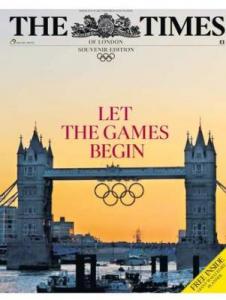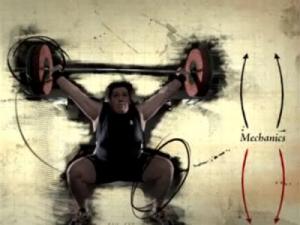On science blogs this week: Challenger
AS YOU MAY HAVE HEARD, THE SUMMER OLYMPICS STARTS TODAY IN LONDON. Herewith, a selective and no doubt incomplete roundup of some 2012 Olympics-related sciencey items.
For the science of the Olympics, a good place to start is a new Dana white paper on mental preparations of top athletes, which Ann Whitman describes at the Dana Foundation Blog. The athletes talk about how they stay calm and focused, and neuroscientists describe relevant research on attention, brain development, action representation, and stress.
For a visual approach, Cosmic Log MSNBC's science editor Alan Boyle describes videos about the science of the Olympics posted at NBC Learn. Chris Gorski links to a few news tidbits about the Olympics at Inside Science. Read about how visitors will spread disease and the 10,000 hacking attempts expected. Per day. Larry Greenemeier dives into consideration of the best freestyle swimming strokes (with videos) at SciAm's Observations.
At Grist, Philip Bump has rounded up links under the hed "Here is everything people have written about sustainability at the Olympics," and then takes it back. But there's certainly a lot. 10K toilets! I really believe that. [A nod to Twenty Twelve, the very funny Britcom about the lead-up to the Olympics. Catch it if you can.]
Under the hed "Olympic Pseudoscience," Steven Novella of Science-Based Medicine recaps a recent British Medical Journal paper evaluating claims of improved sports performance of more than 100 products, ranging from energy bracelets to running shoes. The verdict will probably not surprise you: the claims usually were not borne out. Sometimes a product may work because it relies on well-known benefits that can be had elsewhere more cheaply: nutritional supplements, for example, that are essentially just expensive milk.
Too bad this stuff doesn't work, because London's air pollution — nitrogen dioxide specifically — will narrow the airways of the jocks, according to a sports doc from the American Academy of Allergy, Asthma & Immunology quoted by guest blogger Max Frankel at Climate Progress. The UK is not in compliance with EU air pollution guidelines.
OLYMPICS AT THE HUFFPO BLOGS. Of the scores, maybe hundreds, of Olympics-related blog posts at the Huffington Post, not many have anything to do with science. But you can glean statistics at a HuffPo infographic. Half a million wifi hotspots, it says here.
Astrophysicist Mario Livio plays around with different ways of ranking medal counts, for example by the relative density of medal metals in the universe or their relative abundance. Atoms of copper, which accounts for about 90% of the alloy bronze, are hundreds of times more common than atoms of silver or gold. Copper was made in the cores of massive stars, but it was supernova explosions that created silver and gold. Speaking of putting the metal to the medal, here's a shocker: the silver medals are 93% silver, but so are the (so-called) gold medals: 93% silver and only 1.34% gold.
Greg Downey of Neuroanthropology uses HuffPo to delve into ancient Olympic history and compare today's superbly conditioned athletes unfavorably to the 4 billion unconditioned spectators. He declares
The Olympic Games may be stronger than ever, and world records are liable to tumble in London, but the people watching from home are growing slower, weaker and more sedentary. If the Olympic movement is intended "to encourage and support the development of sport for all," as the Olympic Charter reads, then the movement is in danger of failing, even though the broadcasts are popular.
HOW TO TRACK THE OLYMPICS. For the mobile, there are several ways to keep up besides television and your laptop. Check out Ars Technica's reviews of iPhone apps. They didn't do the same for Android apps, but Simon Sage reviews a bunch at Android Central and Bruce Upbin rounds them up at Forbes. Catholicity rules at the BBC, which offers both.
ABC News describes half a dozen ways of getting Olympics news, generously putting host NBC's offerings first. You can find those NBC apps here. There are dozens of Twitter hashtags for the Olympics, and Twitter is partnering with NBC to be the official narrator of the games, whatever that means. But demand is such that Twitter is having trouble staying up and running; see, for example, this report by Steven Musil at CNET.
THE LATEST ON HIV AND AIDS: A CURE?. As the Olympics takes off, AIDS 2012, the 19th International AIDS Conference, concludes today in Washington, where there was news of a possibly effective therapy.
Bone marrow transplants may have cured two more AIDS patients, according to Richard Knox at the NPR health blog Shots.One of the researchers told Knox
As far as we've been able to measure, we can't find evidence of HIV infection in the patients' blood or blood plasma, and their antibody levels against HIV are dropping.
Meantime, the plan is to treat everybody infected with HIV with antivirals just as soon as they're identified. That's 34 million people, Knox reports. Eight million are getting treatment now, at a cost of $17 billion. Expanding the pool to all who are HIV positive would come to an additional $22 billion. Who will pay? One proposal is new taxes on tobacco and alcohol.
Who will pay was a topic that absorbed the World Bank also, with a panel debating not just costs, but whether HIV was already absorbing resources that should rightfully go to other health crises. One example: the eight million children who die before they're 5, only rarely of AIDS. Amy Maxmen reports at the Nature Newsblog that Jeffrey Sachs wants to soak the rich.
One dilemma for coping with HIV infection is no different from dealing with other infectious agents: If you expand the number of people getting a drug treatment, you also, inevitably, expand the pool of microbes that can fight it off. So it's dismaying but no big surprise that researchers are reporting increased resistance to antiviral drugs in parts of sub-Saharan Africa since they became widely available. Erin Loury reports at the LA Times's Booster Shots.
And what of the progress on prevention? Ed Yong's May post at Not Exactly Rocket Science brings us up to date on the hurdles to developing an HIV vaccine. He explains that
creating an HIV vaccine is like trying to fire a gun at millions of shielded, moving targets. Oh, and they can eat your bullets.REMEMBERING SALLY'S RIDE. Astrophysicist and astronaut Sally Ride's death was a jolt. We want our heroes to live forever, and women just don't die as young as 61 these days. Not that she didn't cram a lot into those 61 years. Beryl Benderly gives Ride a marvelous send-off at her ScienceCareers blog post "Remembering Sally's Ride."



